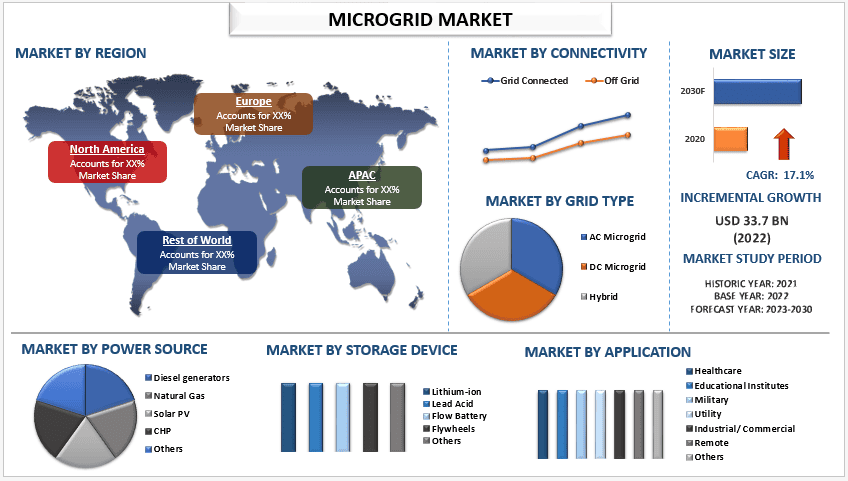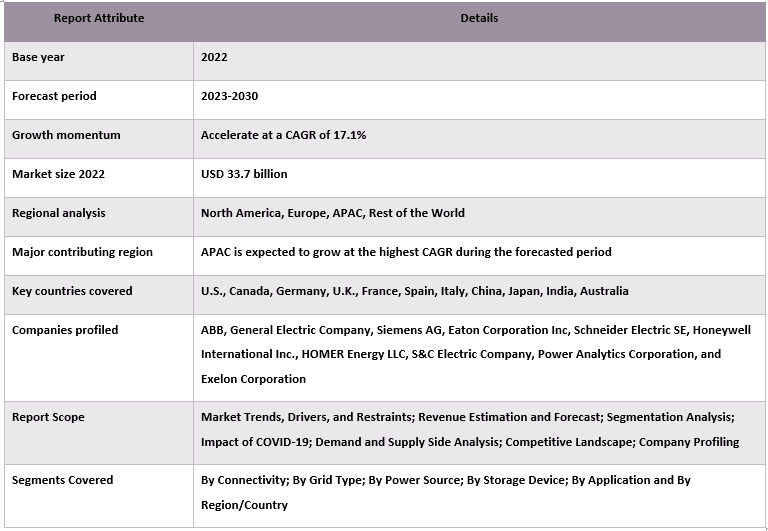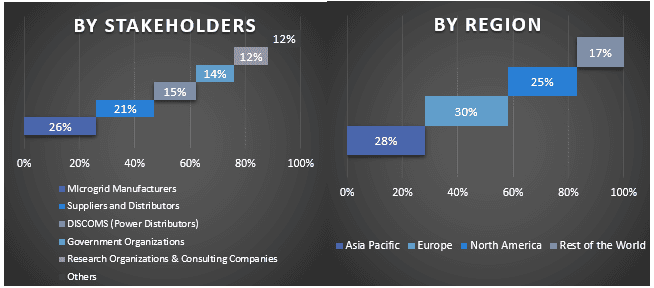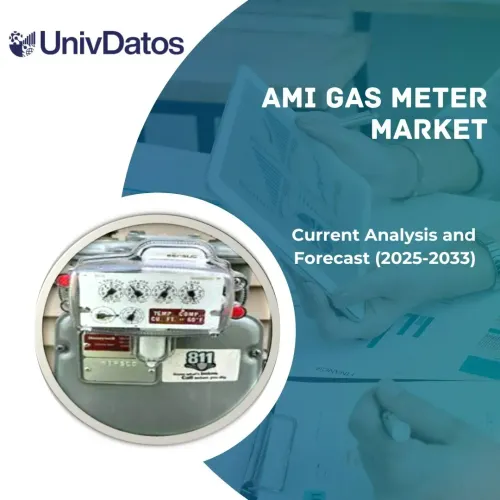- Home
- About Us
- Industry
- Services
- Reading
- Contact Us
Microgrid Market: Current Analysis and Forecast (2023-2030)
Emphasis on Connectivity (Grid Connected, and Off Grid); Grid Type (AC Microgrid, DC Microgrid, and Hybrid); Power Source (Diesel generators, Natural Gas, Solar PV, CHP, and Others); Storage Device (Lithium-ion, Lead Acid, Flow Battery, Flywheels, and Others); Application (Healthcare, Educational Institutes, Military, Utility, Industrial/ Commercial, Remote, and Others); and Region/Country

The Microgrid Market was value at USD 33.7 Billion in year 2022 and is expected to grow at a steady rate of around 17.1% during the forecast period (2023-2030) owing to the increasing investments in renewable energy. Microgrids can be powered by renewable technologies such as wind systems, solar systems, microturbines, hybrid systems, and combustion turbines. Microgrids can be integrated with these renewable technologies to reduce carbon footprints on the environment. Several governments worldwide are taking initiatives to reduce their carbon footprints on the environment, for example, the Government of Delhi, India started a transition to zero-emission vehicles in 2020, aiming to have 25% of all newly-registered vehicles to be EVs by 2024, which number is currently 0.2%. A few drawbacks that the microgrid market can encounter include the initial setting up cost and the high maintenance cost of microgrids. The setting up costs of microgrids are 25-30% higher than the traditional grids. Based on technology, the market is divided into alkaline electrolyzer, PEM electrolyzer, and SO Electrolyzer. Among these, the alkaline electrolyzer dominated the Microgrid and is expected to show the same trend in the forecast period. Alkaline electrolyzers are one of the most common types of technologies used in the production of hydrogen. These systems are usually composed of electrodes, a microporous separator, and an aqueous alkaline electrolyte of around 30% by weight KOH or NaOH solution. Moreover, alkaline electrolyzers provide value advantages over different forms of electrolysis technologies. They employ ample and inexpensive materials, including nickel-based catalysts, which make contributions to their affordability. This makes them a favorable preference for mass manufacturing and huge-scale hydrogen production, supporting the growing demand for clean energy solutions. Furthermore, alkaline electrolyzers have a high conversion efficiency, effectively splitting water into hydrogen and oxygen. This ensures minimal energy losses in the course of the electrolysis procedure, leading to higher overall performance in producing Microgrid. For instance, in 2023, ThyssenKrupp Nucera introduced a new product name for its 20 MW alkaline electrolysis module, which will henceforth be called ‘scalum’. The launch of the new product name marks the next milestone in the long-term development of the ThyssenKrupp Nucera brand.
Some of the major players operating in the market include ABB, General Electric Company, Siemens AG, Eaton Corporation Inc, Schneider Electric SE, Honeywell International Inc., HOMER Energy LLC, S&C Electric Company, Power Analytics Corporation, and Exelon Corporation.
Insights Presented in the Report
“Amongst connectivity, the off gird segment would showcase high growth during the forecast period”
Based on connectivity, the global microgrid market is segmented into Grid Connected and Off-Grid. Amongst connectivity, the off-grid segment of the global microgrid market would register substantial growth during the projected period. The usage of off-grid microgrid systems is gaining popularity as the need for power outages in remote areas is growing. There is an increasing demand for power infrastructure in rural areas and due to this, it is easiest to install off-grid microgrids to enhance the already built-up infrastructures in these regions. Myanmar Government approved the microgrid project developed by Electricite de France (EDF) and InfraCo Asia in 2019 to provide electricity in remote locations such as the Kha Laing Village in Myanmar. Also, in 2018, Canada approved a 3-year plan with a multidisciplinary team in Alberta to lead microgrid projects with industrial and government support.
“Amongst grid type, the AC microgrid segment held the significant market share in 2022”
Based on grid type, the global microgrid market is segmented into AC Microgrid, DC Microgrid and Hybrid. Amongst grid type, AC microgrid accounted for a significant market share in 2022 and is expected to showcase high growth during the projected period. AC microgrids can lower transmission losses with minimal heat generation and have effective high-end voltage levels across the network. This is likely to sway the demand for this technology. Additionally, these are also highly compatible with grid networks and do not need any invertors for power supply. Moreover, they can be deployed with large solar and wind farms which may further enhance their market growth. As most governments around the world are trying to lower their carbon emission this could be a benefit for the market growth of the AC microgrids. For example, in 2020 Santa Barbara allocated over US$ 500,000 to the designing and studying of microgrids for schools around the county. The preliminary assessment by Clean Coalition identified more than 15 megawatts of solar generation potential across and 18 school sites.
“Amongst power sources, the natural gas segment held the significant market share in 2022”
Based on power source, the global microgrid market is segmented into Diesel generators, Natural Gas, Solar PV, CHP, and Others. The natural gas segment captured a significant share in the market in 2022 and is expected to showcase substantial growth during the forecast period. Government policies are favoring the integration of efficient and sustainable power generation to boost the natural gas (NG) powered microgrid infrastructure. Shifting towards renewable power sources and lowering their carbon footprint is boosting the use of natural gas microgrids. In 2020, Stadtwerke Kiel, the municipal utility of Germany inaugurated a new 190 MW CHP natural gas plant and decommissioned the 323 MW CHP coal-fired plant. All developed as well as developing economies are focusing on decommissioning their coal-based pants and minimizing their carbon footprints. Apart from the natural gas microgrids, the Solar PV microgrids are also expected to show a lucrative CAGR during the forecast period.
“Amongst storage device, the lithium-ion segment held the significant market share in 2022”
Based on storage device, the global microgrid market is segmented into Lithium-ion, Lead Acid, Flow Battery, Flywheels, and Others. Amongst storage devices, the lithium-ion segment of the global microgrid market registered major market share in the year 2022 and is expected to showcase substantial growth during the forecast period. Batteries are an important part of the microgrid system as they improve the performance, generator efficiency and system reliability. These storage devices can minimize the fuel consumption. Until recently, lead-acid storage devices were considered the most economical and were the most popular. Recently, lithium-ion storage devices have gained popularity. Even though lithium-ions have a high initial cost which goes as much as US$ 600/kWh, they have benefits like high efficiency (95%) and short discharge time. Power range of lithium batteries is around 100 MW or higher and the response time may be a few milliseconds. This makes them highly efficient and long-lasting which is boosting their popularity and thus market growth. One drawback of lithium batteries is, however, due to their high cost they are less favorable in remote locations.
“Amongst application, the industrial/commercial segment held the significant market share in 2022”
Based on application, the global microgrid market is segmented into Healthcare, Educational Institutes, Military, Utility, Industrial/ Commercial, Remote, and Others. Amongst application, industrial/commercial segment accounted for a significant market share in 2022 and would showcase ample growth during the projected period. The growing efforts of the government to revamp and reconstruct the existing T&D networks along with the installation of energy-efficient solutions will help drive the business outlook. For example, the State grid of Liu Zhenya of China has nearly 1 million employees and 1.1 billion customers and has plans to connect the entire world with transmission lines, starting with Asia. Industrial and commercial sectors are focusing of developing intelligent solutions across new as well as conventional grid infrastructures. The incline of government authorities to reduce carbon emissions across the electrical network is boosting market growth as well as technological advancements in grid modernization.
“APAC will showcase substantial growth during the projected year in the Microgrid market”
APAC has dominated the market and is projected to be the dominating region in the forecast period. There are many developing countries in Asia-pacific including India, China, Indonesia etc. Over the decades, urban areas have developed with good grid infrastructure, but rural areas have been deprived of this. With the help of microgrid systems, electrification can reach rural and less privileged regions. This is possible because microgrids are cost-effective and can save the money needed for transmission and distribution equipment. There can reach remote locations. Additionally, as they are rural energy-based, they can comply with the Paris Agreement and other sustainable climate pacts and are helping the countries promote clean energy policies. For example, half of the Indonesian population is living in rural regions, and with the help of microgrids, over 88% of Indonesia has access to electricity. Additionally, India has over 160 microgrid solutions spread over four Indian States – Bihar, Uttar Pradesh, Rajasthan, and Odisha. Over 80% of these microgrids are solar-powered.
Microgrid Report Coverage

Reasons to buy this report:
- The study includes market sizing and forecasting analysis validated by authenticated key industry experts.
- The report presents a quick review of overall industry performance at one glance.
- The report covers an in-depth analysis of prominent industry peers with a primary focus on key business financials, product portfolios, expansion strategies, and recent developments.
- Detailed examination of drivers, restraints, key trends, and opportunities prevailing in the industry.
- The study comprehensively covers the market across different segments.
- Deep dive regional level analysis of the industry.
Customization Options:
The global Microgrid market can further be customized as per the requirement or any other market segment. Besides this, UMI understands that you may have your own business needs, hence feel free to connect with us to get a report that completely suits your requirements.
Table of Content
Research Methodology for the Microgrid Analysis (2023-2030)
Analyzing the historical market, estimating the current market, and forecasting the future market of the global Microgrid market were the three major steps undertaken to create and analyze the adoption of Microgrid in major regions globally. Exhaustive secondary research was conducted to collect the historical market numbers and estimate the current market size. Secondly, to validate these insights, numerous findings and assumptions were taken into consideration. Moreover, exhaustive primary interviews were also conducted, with industry experts across the value chain of the global Microgrid market. Post assumption and validation of market numbers through primary interviews, we employed a top-down/bottom-up approach to forecasting the complete market size. Thereafter, market breakdown and data triangulation methods were adopted to estimate and analyze the market size of segments and sub-segments of the industry pertains to. Detailed methodology is explained below:
Analysis of Historical Market Size
Step 1: In-Depth Study of Secondary Sources:
Detail secondary study was conducted to obtain the historical market size of the Microgrid market through company internal sources such as annual reports & financial statements, performance presentations, press releases, etc., and external sources including journals, news & articles, government publications, competitor publications, sector reports, third-party database, and other credible publications.
Step 2: Market Segmentation:
After obtaining the historical market size of the Microgrid market, we conducted a detailed secondary analysis to gather historical market insights and share for different segments & sub-segments for major regions. Major segments included in the report are Connectivity, Grid Type, Power Source, Storage Device, and Applications. Further country-level analyses were conducted to evaluate the overall adoption of testing models in that region.
Step 3: Factor Analysis:
After acquiring the historical market size of different segments and sub-segments, we conducted a detailed factor analysis to estimate the current market size of the Microgrid market. Further, we conducted factor analysis using dependent and independent variables such as Connectivity, Grid Type, Power Source, Storage Device, and Applications of the Microgrid market. A thorough analysis was conducted for demand and supply-side scenarios considering top partnerships, mergers and acquisitions, business expansion, and product launches in the Microgrid market sector across the globe.
Current Market Size Estimate & Forecast
Current Market Sizing: Based on actionable insights from the above 3 steps, we arrived at the current market size, key players in the global Microgrid market, and market shares of the segments. All the required percentage shares split and market breakdowns were determined using the above-mentioned secondary approach and were verified through primary interviews.
Estimation & Forecasting: For market estimation and forecast, weights were assigned to different factors including drivers & trends, restraints, and opportunities available for the stakeholders. After analyzing these factors, relevant forecasting techniques i.e., the top-down/bottom-up approach were applied to arrive at the market forecast for 2030 for different segments and sub-segments across the major markets globally. The research methodology adopted to estimate the market size encompasses:
- The industry’s market size, in terms of revenue (USD) and the adoption rate of the Microgrid market across the major markets domestically
- All percentage shares, splits, and breakdowns of market segments and sub-segments
- Key players in the global Microgrid market in terms of products offered. Also, the growth strategies adopted by these players to compete in the fast-growing market
Market Size and Share Validation
Primary Research: In-depth interviews were conducted with the Key Opinion Leaders (KOLs) including Top Level Executives (CXO/VPs, Sales Head, Marketing Head, Operational Head, Regional Head, Country Head, etc.) across major regions. Primary research findings were then summarized, and statistical analysis was performed to prove the stated hypothesis. Inputs from primary research were consolidated with secondary findings, hence turning information into actionable insights.
Split of Primary Participants in Different Regions

Market Engineering
The data triangulation technique was employed to complete the overall market estimation and to arrive at precise statistical numbers for each segment and sub-segment of the global Microgrid market. data was split into several segments & sub-segments post studying various parameters and trends in the areas of Connectivity, Grid Type, Power Source, Storage Device and Applications in the global Microgrid market.
The main Objective of the Global Microgrid Study
The current & future market trends of the global Microgrid market were pinpointed in the study. Investors can gain strategic insights to base their discretion for investments on the qualitative and quantitative analysis performed in the study. Current and future market trends determined the overall attractiveness of the market at a regional level, providing a platform for the industrial participant to exploit the untapped market to benefit from a first-mover advantage. Other quantitative goals of the studies include:
- Analyze the current and forecast market size of the Microgrid market in terms of value (USD). Also, analyze the current and forecast market size of different segments and sub-segments
- Segments in the study include areas of Connectivity, Grid Type, Power Source, Storage Device, and Applications
- Define and analysis of the regulatory framework for the Microgrid industry
- Analyze the value chain involved with the presence of various intermediaries, along with analyzing customer and competitor behaviors of the industry
- Analyze the current and forecast market size of the Microgrid market for the major region
- Major countries of regions studied in the report include Asia Pacific, Europe, North America, and the Rest of the World
- Company profiles of the Microgrid market and the growth strategies adopted by the market players to sustain in the fast-growing market
- Deep dive regional level analysis of the industry
Related Reports
Customers who bought this item also bought










